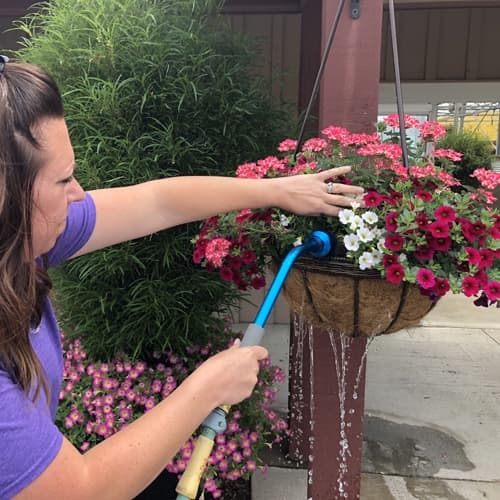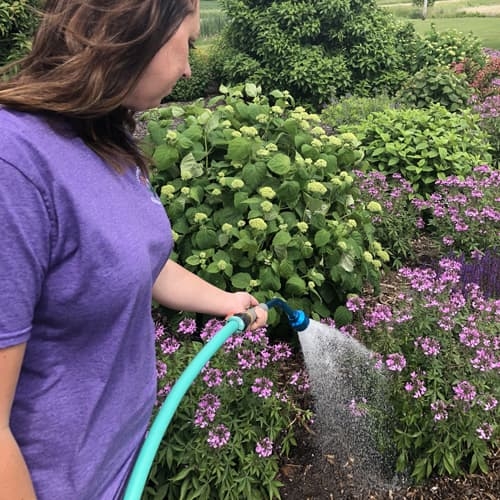
You’ve planted up your containers and added new perennials and shrubs to your landscape. Now how often and how much do you need to water them? Let’s take a look at the specifics of watering to get those new plants growing.
PLANTS GROWING IN CONTAINERS

Generally speaking, most plants growing in containers need to be watered more frequently than plants growing in the ground. Potting soil is typically very light and well-drained to help the plants’ roots grow, but this type of soil dries out faster than heavier garden soil. Also, the limited amount of soil in a container cannot hold as much moisture as deep garden soil.
How often you’ll need to water your plants growing in containers depends on several factors including:
Exposure – Container plants grown in full sun will dry out much faster than those in shade, so you’ll need to water them more often. Containers exposed to wind or steady air flow, such as hanging baskets, dry out faster than those in protected areas. If your containers are growing in a sunny, exposed area, consider hooking them up to a WaterWise drip irrigation system so they’ll be watered consistently.
Size and Material of the Container – Small containers that hold little soil will dry out much faster than large containers, so plan to water them more often. Non-porous containers like glazed pottery, plastic and lightweight foam will keep the water from evaporating through the sides of the container. Porous ones like unglazed terra cotta will dry out faster because moisture will evaporate from all sides.
The Types of Plants You Are Growing – Some plants naturally require more water to remain healthy than others that are drought tolerant. The plant label typically describes the plant’s water preferences. Those that need consistent moisture, like New Guinea impatiens and browallia, will need to be watered more frequently than those that prefer drier soils like lantana and moss roses.
PLANTS GROWING IN THE LANDSCAPE

Plants growing in the ground typically require less frequent watering than those planted in containers because there is more soil available to hold moisture, and the soil is typically denser. You might water your containers of petunias every day in high summer but water the same petunias growing in the ground every 2-3 days.
How much and how often you need to water your plants growing in the landscape depends on several factors including:
Soil Type – Sandy soil with little organic matter requires the most amount of water because it drains quickly through. Adding compost, humus, manure or top soil will increase the water holding capacity of sandy soil. Heavier clay soils are excellent at retaining moisture but tend to dry very hard once the moisture has been used up. Amending heavy clay soils with organic material will help to break up their dense texture and create air spaces which will allow the water drain through them more easily.
How Well Your Plants Are Established – Newly planted perennials and shrubs should be watered regularly without allowing the soil to dry out for the first season. This will encourage new roots to settle in and become established. You’ll know it’s time to water again when the first two inches of soil are dry to the touch and lighter in color. Once established, most perennials and shrubs only require an average of one inch of water per week.
Drought Tolerance – Once they are established, drought tolerant perennials and shrubs will only need supplemental water when there is no rain for several weeks. While they wait for rain to arrive, most drought tolerant plants have built-in water saving mechanisms, like plump leaves that store water or fuzzy foliage that slows evaporation.
WATERING QUICK TIPS
- Don’t wait until your plants wilt to water them. Check the soil regularly to see if it is time to water. When it is dry to the touch one inch down in the container and the container is light, it’s time to water.
- When hand-watering plants, direct the stream of water towards the soil, not the foliage. The roots are what will take up the moisture, not the foliage.
- Water containerized plants until the water flows out the drain hole in the bottom of the pot. A little sprinkle is not enough water to reach the roots.
- Water early in the morning to allow the foliage to dry before sunset. Keeping the foliage dry helps to prevent diseases from moving in.
Ornamental plants generally require more water than your lawn. Most automatic sprinkling systems are set to give the lawn enough moisture, but not your garden beds. Test your system by placing a bucket in your garden and letting your sprinklers run through a full cycle. If there is less than one inch of water in the bucket at the end of the cycle, you’ll need to increase the amount of time your sprinklers run.
